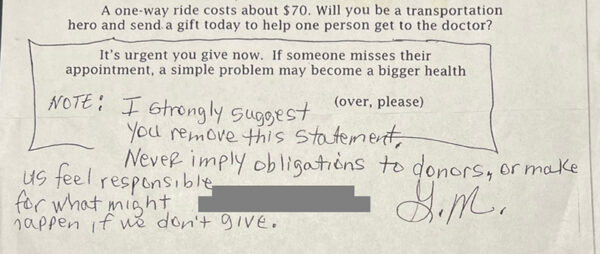“Talking to donors about what they care about, in language that they quickly understand, absolutely leads to raising more money and doing more good.”
Steven learned this truth early on in his career and I think it’s a great reminder for anyone fundraising through the pandemic.
Bottom line is that your donors are not experts on your organization, or your programs. If you want to see results, be sure to keep your message simple, specific, and solution-focused. Your donors want to support outcomes, not processes.
That said, there’s a cost to fundraising this way because the experts in your organization won’t like it. But the benefits to your mission are clear.
— Jonathan
Think of this post as a brief introduction to the idea that being an expert about your field, or about your organization, can cause your fundraising to raise less money.
I’m going to cover three things very quickly:
- Define “The Curse of Knowledge”
- Show how knowledge or expertise often hurts fundraising
- Talk about how to get past it to raise more money
The Curse of Knowledge
Wikipedia says, “The curse of knowledge is a cognitive bias that occurs when an individual, communicating with other individuals, unknowingly assumes that the others have the background to understand.”
You know the feeling, right? You’re listening to an expert talk about something and you’re thinking, “That sounds really smart, but I’m not totally sure what everything meant.”
Let me submit to you that donors have that reaction All The Time when they read fundraising.
How Knowledge Hurts Fundraising
This is very simple:
- Experts use jargon. They say that a child is “food insecure” instead of “often goes to bed hungry.”
- They use conceptual language. They say “Will you stand behind the victims…” instead of “Will you give a victim exactly what she needs to recover…”
- The write at a high grade level that takes more cognitive effort to understand.
- Experts don’t like to talk about the Need. So they talk almost exclusively about the successes – which unfortunately hides the Need from donors.
- They think about groups of people instead of one person who needs help. They’ll say, “Will you support vulnerable children…” instead of “Will you help a child who needs help now…”
All of these things make the fundraising sound smart and technically accurate – to experts.
But these traits make fundraising harder to read and understand by a donor who isn’t an expert. And – this is important – who is only looking at your letter or email for a few short seconds.
How to Avoid the Curse
Always remember who you are talking to: non-experts. So instead of saying, “Our holistic approach,” say, “Your gift helps them every single way they need help.” Instead of saying, “Your support will provide employment resources to disadvantaged people,” say, “You’ll give a job-seeker everything she needs to get a job.” This approach will sound overly simple to you, and will sound just right to your donors.
Always remember how you are talking to them – in a medium (usually in a letter or email) where most donors only give you a few short seconds of attention. You don’t have time to make complex arguments. This is not a conference or a meeting with a Foundation where you have lots of time, and people want to see the data. For mass donor fundraising you need to make it easy for your reader to know exactly what you’re talking about, and do it quickly.
The Cost and the Incredible Benefit
There’s a cost to doing fundraising this way: the experts in your organization won’t like your fundraising. This is a personal, subjective reaction because your fundraising won’t be written to their level of understanding and expertise.
That’s a real cost. Some organizations never pay it.
But the benefit is clear: talking to donors about what they care about, in language that they quickly understand, absolutely leads to raising more money and doing more good.
If you’re an expert, is that benefit worth the cost?
This post was originally published on November 13, 2018.










